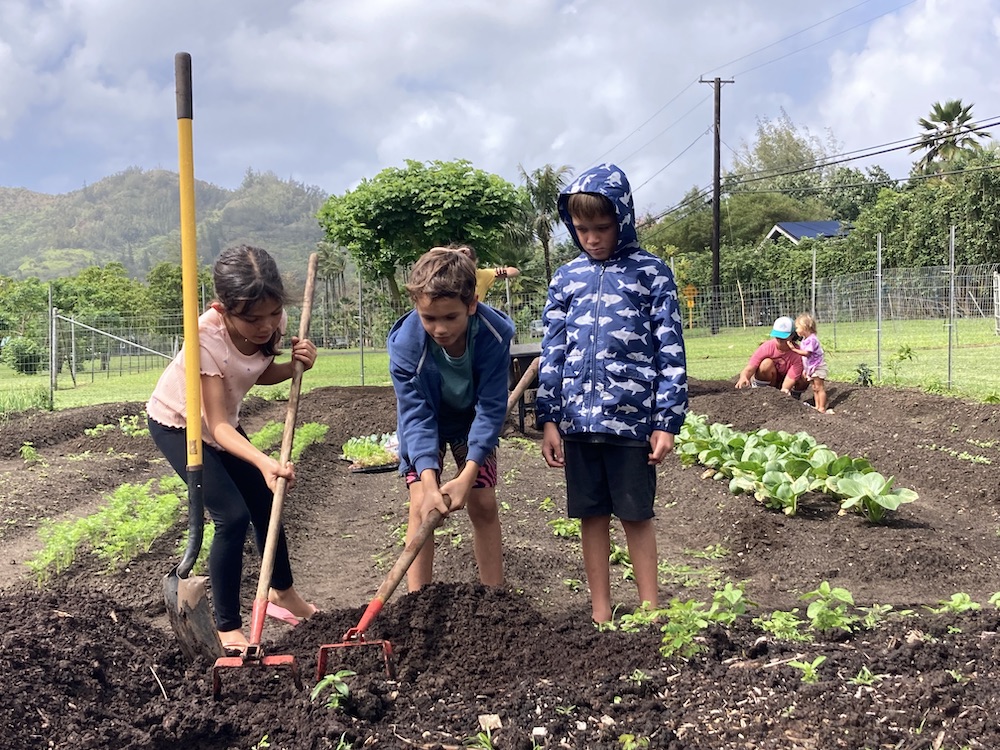
- Details
- By Jenna Kunze
Hawaiʻi is home to nearly half the country’s threatened or endangered species. A Native Hawaiʻian school system that provides land for more than 300 of the state’s threatened, endangered, or rare species is building back Indigenous forests, while also training the next generation of land protectors.
This story was produced as part of the Solution Journalism Network’s 2022 Climate Cohort.
ISLAND OF HAWAIʻI—Botanists Reid Loo and Nāmaka Whitehead speak about the Indigenous plants of Hawaiʻi Island as though they are speaking about relatives. As Native Hawaiʻians, they are. They remember what certain plants looked like as babies, where they’ve traveled to and from, and the folklore of those relatives they never got a chance to meet.
“We recognize a shared ancestry with our islands and all of the species, the landforms, the weather forms, and everything else that exists upon our islands,” said Whitehead, a senior natural resource manager for the Kamehameha Schools, the largest land steward in the state of Hawaiʻi. “They shaped who we are as Hawaiʻians— every single one of them— and therefore, they're all critical to our identity.”
Since British explorer James Cook landed on Kauaʻi Island in 1778, invasive species have afflicted the Hawaiʻian ecosystem—from early European settlers and American missionaries who introduced new diseases and colonial attitudes, to pigs and goats the colonizers brought with them that fed on Indigenous vegetation. In more recent times, a fast-killing fungus wiped out thousands of Hawaiʻi’s sacred ʻōhiʻa trees, and the tourism industry that took root in the 1960s has exponentially driven up the cost of property and rent, resulting in disproportionate levels of homelessness among Native Hawaiʻians.
Hawaiʻi is a hotspot for biodiversity preservation, in part because of the dangers it’s up against: More than 100 plant species have already gone extinct, and nearly a third of its roughly 1,400 plant species—the vast majority of which are found nowhere else in the world—are listed as threatened or endangered, according to the state Division of Forestry and Wildlife. While Hawaiʻi makes up barely 0.3% of the nation’s total land mass, it’s home to 44% of the country’s endangered and threatened plant species. It has been dubbed the “extinction capital of the world.”
Over the last 20 years, Kamehameha Schools—an Indigenous-led school system—has been utilizing its two largest assets to restore Hawaiʻian identity: the thousands of acres of land it owns, and its predominantly Native Hawaiʻian student body to care for and learn from the land. Through various programs and partnerships, the school has revived thought-to-be-extinct species, restored Indigenous forests across the state, and brought Native Hawaiʻians back to the lands they’ve been dispossessed of.
“We want our people to engage more with endangered species so that they can know and love them,” Whitehead told Native News Online at the school’s West Hawaiʻi office in late January. “That relationship is really critical both to our own health and identity, but also to the continued survival of the species. If we don't know them, then people won't care about them.”
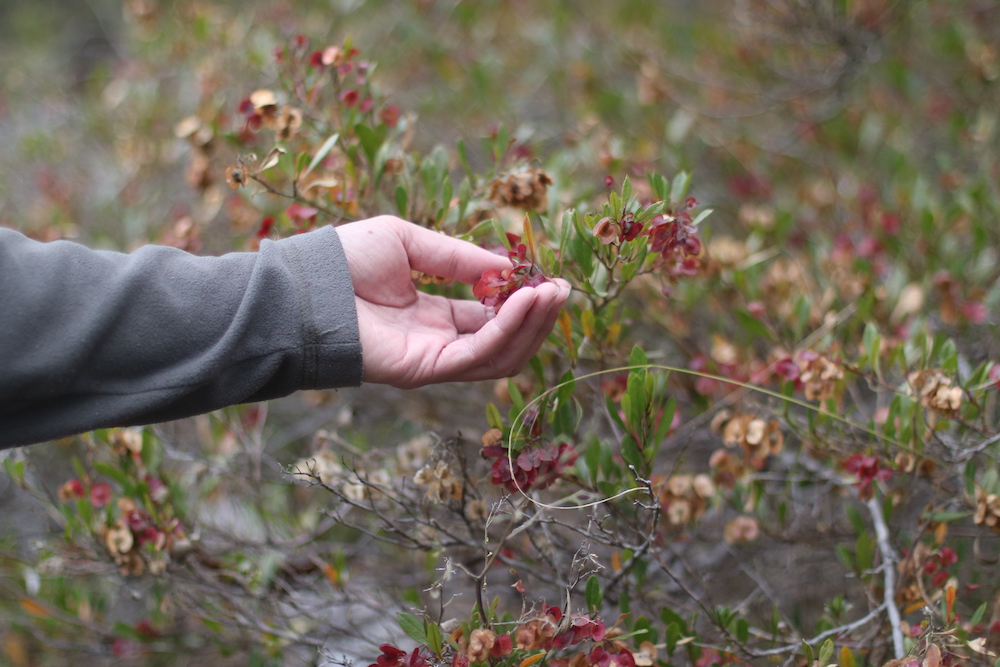 PICTURED: Reid Loo explains the importance of aʻaliʻi, or Dodonaea viscosa growing in one of the Indigenous forests Kamehameha Schools keeps as conservation lands in January. The plant is traditionally used to make medicines, lei, and more. (Photo: Jenna Kunze)
PICTURED: Reid Loo explains the importance of aʻaliʻi, or Dodonaea viscosa growing in one of the Indigenous forests Kamehameha Schools keeps as conservation lands in January. The plant is traditionally used to make medicines, lei, and more. (Photo: Jenna Kunze)
The wish of a princess
Kamehameha Schools was founded in 1887 through the land endowment of former Native Hawaiʻian Princess Bernice Pauahi Bishop, the great-granddaughter of King Kamehameha I, who united the islands into the Kingdom of Hawaiʻi in the early 1800.
In 1883, ten years before the overthrow of the Kingdom of Hawaiʻi, the Princess, “witness[ing] the rapid decline of the Hawaiʻian population, along with the loss of Hawaiʻian language, culture, and traditions,” conveyed her estate to create a school system that prioritized Native Hawaiʻian enrollment. But those efforts were thwarted after the U.S. illegally annexed Hawaiʻi in 1900, and Kamehameha Schools was counted among seven Indian boarding schools statewide that operated with “deliberate polic[ies] to suppress ‘Ōlelo Hawai‘i’’ or Native Hawaiʻian language.
Kamehameha Schools is the only institution that remains open today, with the mission to help students “deepen their connection to culture and ‘āina,” or love of the land.
In 2021, Kamehameha Schools enrolled 1,403 students—the majority of whom identify as Native Hawaiʻian—on three campuses, according to the school’s annual report.
The princess’s 375,000 acres, about 9% of the total landmass in Hawaiʻi, remain the largest private land holding in the state. Kamehameha Schools leased most of the land for ranching up through the late ’90s, botanist Whitehead told Native News Online, but over the last 20 years, the school has reoriented itself towards conservation and preservation.
That shift came from a change in Indigenous leadership after four respected elders in 1997 publicly charged those managing Kamehameha School’s estate with “gross incompetence and massive trust abuse.” Around the same time, there was a rise of community activism around “āina-based learning” (land-based learning) and changes in the Hawaiʻi ranching sector.
After a reorganization in the early 2000s, Kamehameha Schools created its cultural resource department and an ‘Āina Ulu program — an arm of the school that integrates culture and place-based education into its curriculum.
Through ‘Āina Ulu, Kamehameha Schools leases its land to about 20 Native Hawaiian organizations that each steward and conduct eco-cultural education for school children and community members. Of the school’s 190,000 conserved acres, about a quarter of it is stewarded by Native Hawaiian organizations and used for place-based learning.
“Somebody smart looked at the economics and said ‘Hey, we lease our lands to any generic Tom, Dick or Harry, as long as they pay us,’” Mahealani Matsuzaki, the Āina Ulu program’s land education administrator for the last 16 years told Native News Online. “But if we rented it to our own Native peoples, both as regular tenants, (and) as Hawaiʻian nonprofits, we would magnify our mission. The Native Hawaiʻian organizations actually bring back Hawaiʻians to a community that has been dispossessed because of the cost it takes to live or work there.”
Whitehead described the divergence in Kamehameha School’s land management as a re-alignment with Princess Bernice Pauahi Bishop’s original mission to serve her people.
“It was a larger shift in thinking—or perhaps a return in thinking— about our relationship with and stewardship of ʻāina, as well as the role of ʻāina in achieving our mission,” Whitehead said.
From pasture to ‘recovering Native forest’
At the foothills of Volcanoes National Park on the eastern side of the “Big Island” of Hawaiʻi, Reid Loo stops his pickup truck short outside a chain-link fence that asks visitors “Please Close the Fence—Ungulate-Free Zone.”
We are entering Keauhou, Kaʻū Forest (Keauhou is located within the larger district of Ka‘ū, so the forest name follows the format similar to: city, state) indicates a sprawling preserve of 32,000 acres.
 PICTURED: The entrance to Keauhou, Kaʻū Forest. (Photo: Jenna Kunze)
PICTURED: The entrance to Keauhou, Kaʻū Forest. (Photo: Jenna Kunze)
The fencing that has surrounded the property since the early 2000s has kept out ungulates—hooved mammals such as pigs, goats, and deer—who pose some of the biggest threats to biodiversity in the state. With no natural predators, ungulates run wild and have devastated the island’s natural biodiversity by overgrazing on native plants, eroding the soil, and disturbing the earth to create rooting opportunities for invasive plant species and mosquitoes, botanists say.
“The history of fencing is really important, because ungulates modify our natural environment… by opening up space, which is then colonized by invasive species,” Loo said. He starts “nerding out” on the dimensions of the fence the school has specifically contracted to taper out at the bottom, to let small animals through but not wild ungulates. “And that competes with our native flora, which then declines, because invasive species typically are faster growing. That's what slowly causes habitat to decline.”
The fences’ value is clearly illustrated: Just outside of the gate, the land is cleared and looks like a grazed pasture. Inside the fence, there is a lush canopy of 100-foot-tall trees and other plants that stretches for miles.
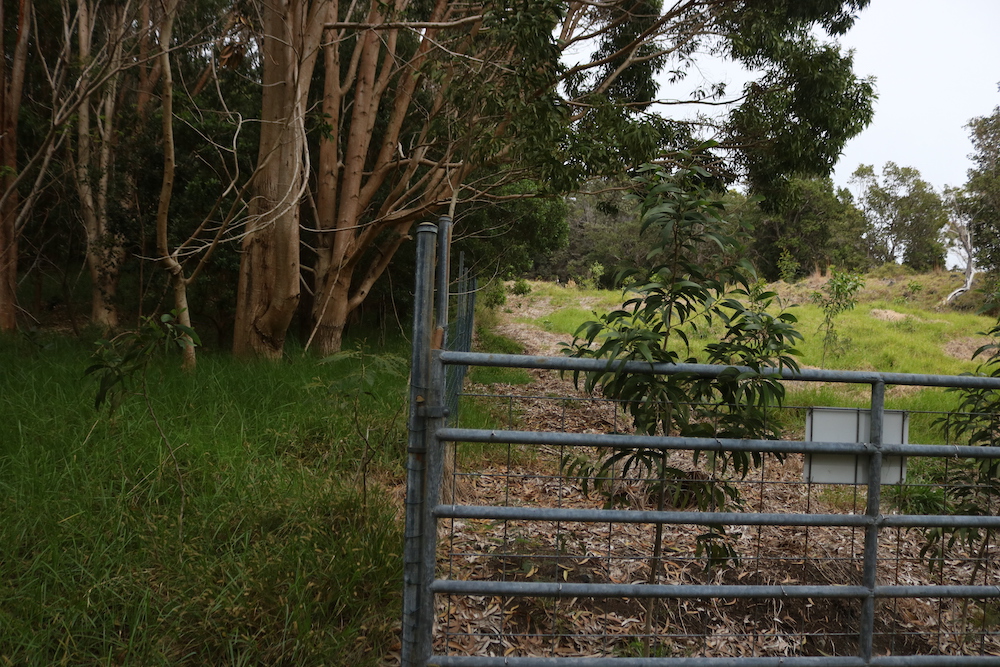 PICTURED: The gate separating Keauhou, Kaʻū Forest's protected forest (left) from grazed pasture. (Photo: Jenna Kunze)
PICTURED: The gate separating Keauhou, Kaʻū Forest's protected forest (left) from grazed pasture. (Photo: Jenna Kunze)
But that doesn't mean that the forest is safe from all threats.
In late 2015, land stewards across Hawaiʻi Island started noticing a disturbing trend: the yellowing and rapid dieoff of ʻŌhiʻa trees, one of Hawaiʻi’s most sacred and ecologically important trees. More than 100,000 ʻŌhiʻa trees, which compose 80% of the states’ native forests— or one million acres— have died in the last several years, according to the Department of Land and Natural Resources. Rapid ʻŌhiʻa Death (ROD), a little-known fungal disease, can kill the trees within a few weeks, sometimes within a few days.
When even just one ʻŌhiʻa dies, Whitehead said, it can have cascading effects on the local ecosystem. “We have tons of birds that rely on ʻŌhiʻa for all of their needs,” she said. “There's birds that only feed on the nectar of Ōhiʻa and birds that only eat insects that live between the leaves of the Ōhiʻa, and birds that only nest in cavities of the Ōhiʻa. If the Ōhiʻa forest dies, they die, too.”
The trees also provide a canopy for the forest, she added, so their death brings light in that enables weeds to grow and overwhelm native species.
‘A bright spot of hope in the conservation community’
Whitehead has worked for Kamehameha Schools’ natural-resources team for two decades. Conservation work can be painful, she said, and sometimes feels like a losing battle.
“It hurts the core of your being when you see [invasive species like ROD], because the Ōhiʻa was already ancient when all of these things that I read about in my history happened. This tree was ancient when Kamehameha was alive, and it’s going to die.”
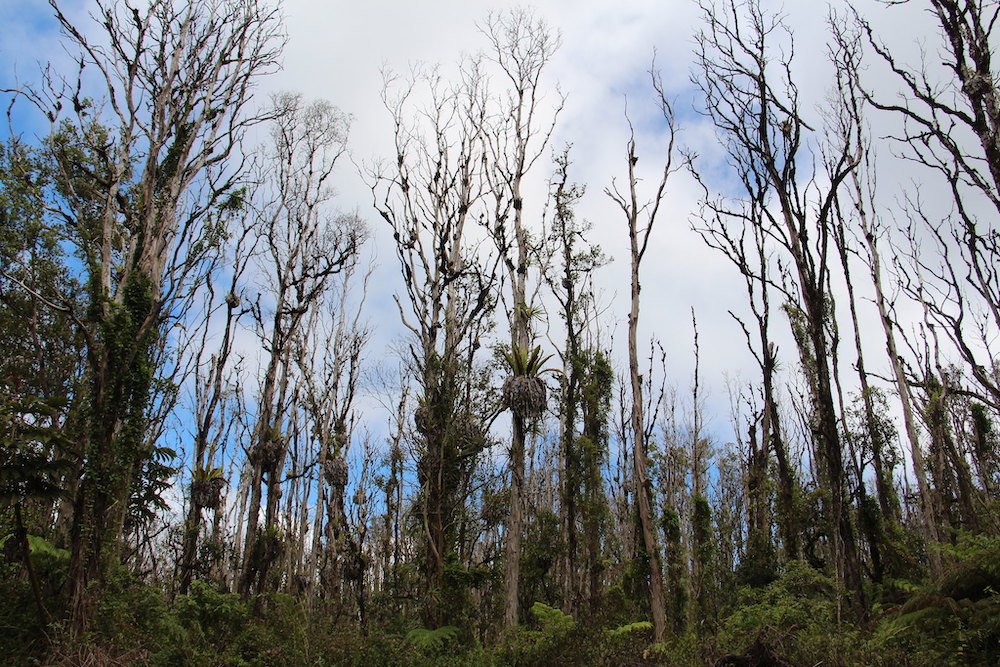 PICTURED: In late 2015, ʻŌhiʻa trees, one of Hawaiʻi’s most sacred and ecologically important trees, began to rapidly die off from a fungal disease. More than 100,000 of the trees have died in the last several years, according to the Department of Land and Natural Resources. (Photo J. B. Friday, University of Hawaii)
PICTURED: In late 2015, ʻŌhiʻa trees, one of Hawaiʻi’s most sacred and ecologically important trees, began to rapidly die off from a fungal disease. More than 100,000 of the trees have died in the last several years, according to the Department of Land and Natural Resources. (Photo J. B. Friday, University of Hawaii)
That is why a staff member’s recent discovery of a thought-to-be extinct plant species on Kamehameha School land has become a symbol of hope for Whitehead and the Native Hawaiʻian communities.
In March 2021, a land steward from the Three Mountain Alliance, a partner organization, found a pod of three Delissea argutidentata plants poking out of a crater while she was collecting seeds from a nearby restoration area.
“She knew it was special, but didn’t know what it was,” Whitehead recounted. “It's a storied plant from this particular landscape. If you are a botanist who does any work in Kona, you have heard of this plant, because it has such a unique growth form. It has a relatively small-diameter trunk, and it used to grow straight up with no leaves or branches into the very top of the plant and then there would be this big poof of leaves. They were very tall, much taller than any other plant in its family.”
The plant, which can grow up to 35 feet tall, had been thought to be extinct in the wild for years. In 1992, a single Delissea argutidentata plant was found in a forest preserve in Kona on the Hawaiʻi Island, but it died in 2002. Some seeds were collected from that individual specimen and grown in a greenhouse, and several of its outplanted seeds that were reintroduced into the wild survive today.
In partnership with the state Department of Land and Natural Resources and the Three Mountain Alliance— a nonprofit organization funded by Kamehameha Schools and operated under the Research Corporation of the University of Hawaiʻi—Whitehead and her small team planted 31 Delissea plants, using seeds from the plant found in March 2021.
Of the 16 recognized species of Delissea, 14 are extinct, and the remaining two are endangered, according to Kamehameha Schools. The botanists can find no record of a Hawaiʻian name for Delissea argutidentata, but they guess it is related to a similar genus, Hāhā, which co-evolved with native birds.
“Hāhā are used in different ways,” Whitehead said. “People would [steam and] eat the leaves, but they primarily were a food source for native birds. All of the plants in the lobelia family that we have in Hawaiʻi have flowers that have this curved shape, the same curve as the bill of native birds. And without the plant, you can't have a healthy bird population, and without those birds, you can't really have healthy populations of these native lobelia, because they are what pollinate the flowers.”
Reviving extinct or endangered species is the name of the conservation game, but it's not always successful, Whitehead said. Kamehameha School’s lands provide habitat for over 302 rare species, 55 of which are being actively stewarded through recovery actions, including producing new plants from a parent plant, and outplanting.
“This kind of success story isn't something that we see very often to this level where the outplants are doing well,” she said. “This bright spot of hope in the conservation community (shows) there are positive things happening, and we can persist and overcome.”
The message extends to all Native Hawaiʻian relatives, she said.
“It's the same thing with our people. There's so many Hawaiʻians in jail and using drugs, and there's parts of our community where there's no jobs, nobody can afford houses, everybody has to move away. There’s so many problems in our communities, but stories of hope can uplift people, and we like to think that the connections that people are able to make to the forest strengthens their identity and their pride and who they are as Native Hawaiʻians.”
A Living Classroom
On a dewy morning in January, a group of five high school students stood in a line at the entrance of the gate to Kamehameha Schools’ Keauhou, Kaʻū Forest, wind pushing their hair back. In Hawaiʻian language, they asked educators on the inside of the fence for entry through a call-and-response song.
“Protocol,” Lahela Camara calls it. She’s the environmental educator for Three Mountain Alliance. She uses the song to welcome students to the forest by allowing them to ask permission for entry.
When permission is granted, the group’s teacher steps forward and offers hugs and an Aloha to each educator inside.
“So much of our connection [to our environment] has been severed by not having it in schools, or [incorporated in] just the way we live,” Camara told Native News Online. She said that Āina-based learning, or the outdoor education programs she runs—where community members come to Keauhou, Kaʻū Forest to plant trees, learn about endangered birds and plants, and connect with their Indigenous forests— are helping to restore that link.
It’s also helping get Native people back to the places they once had access to—as Hawaiʻi's tourism boom continues to drive up the cost of living.
Kamehameha’s oldest community partner, The Waipā Foundation and its predecessor organization, has been leasing 1,600 acres of land from the school on Kauaʻi’s North shore since the late 1980s, when local Hawaiʻian families learned of a resort and golf course development plan for the land. They organized to oppose the development, and proposed a different use for the space: a living learning center.
For decades since, The Waipā Foundation has served as a classroom for the continued practice and perpetuation of Hawaiʻian values and culture. A few of its regular events to fulfill its mission of restoring a vibrant ecosystem while inspiring healthy communities include: farmer’s markets, community work days, and a weekly poi days, where community members come to make poi— a staple food in the Hawaiʻian diet made from taro plants— and distribute it at cost to families throughout the island.
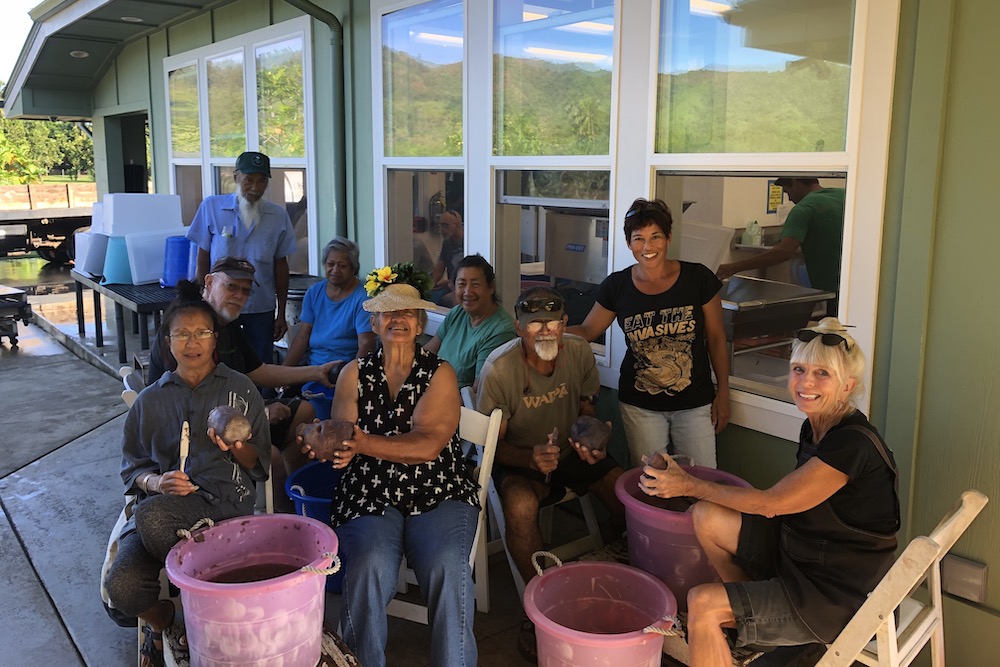 PICTURED: Community members, including Sproat (second from the right) gather to make poi through The Waipā Foundation's weekly program. (Photo courtesy of Waipā).
PICTURED: Community members, including Sproat (second from the right) gather to make poi through The Waipā Foundation's weekly program. (Photo courtesy of Waipā).
Through school field trips and extra-curricular activities, the organization in 2022 also welcomed more than 1,350 learners of all ages to participate in hands-on, land-based learning, Waipā executive director and Kamehameha graduate Stacy Sproat told Native News Online. A little less than half self-identified as Native Hawaiʻian, though racial data wasn’t collected from every participant.
While Waipā welcomes all visitors, Sproat said they run additional programs with local kids that focus on maintaining their connection with place and culture.
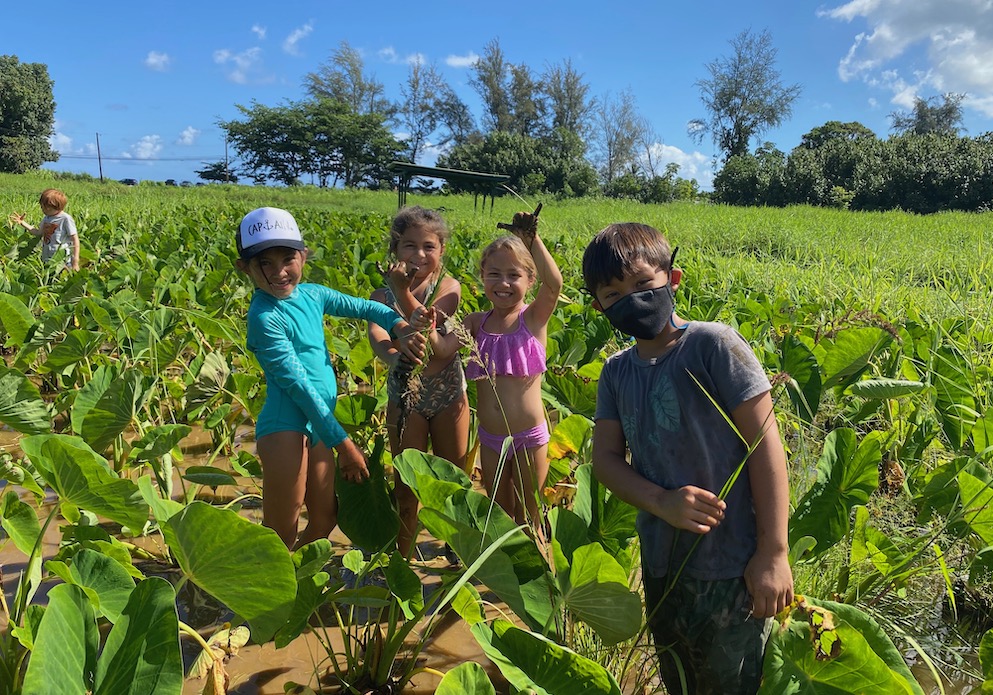 PICTURED: Kamehameha students working in the fields on March 1, 2023. (Photo: Stacy Sproat)
PICTURED: Kamehameha students working in the fields on March 1, 2023. (Photo: Stacy Sproat)
“In Hawaiʻi, and as with most Native people, we have been losing land and access to resources for hundreds of years,” Sproat said. “The colonization continues because of the severe gentrification of the communities surrounding Waipā. The social landscape and fabric of our community has been changing, to the point where now there are very few longtime families in our community.”
Ka’ui Fu, 36, comes from one of those local multi-generational families on Kauaʻi. As a middle schooler in the late 90s, she was a participant in one of Waipā’s first afterschool programs to connect youth to their community. Now she’s been groomed by Sproat to eventually take over the organization.
“At the heart of it, āina-based education has inspired me by giving me different ways that learning in a classroom could not,” Fu said. “I grew up in a traditional Hawaiʻian family, and that’s why my parents always had an interest in me being closer to my culture.The strength of āina-based education is that you’re learning specifically from place, with people. It opened my eyes to … new avenues of learning, new career paths, and being outside of the classroom with a cohort of people that were my family and my peers.”
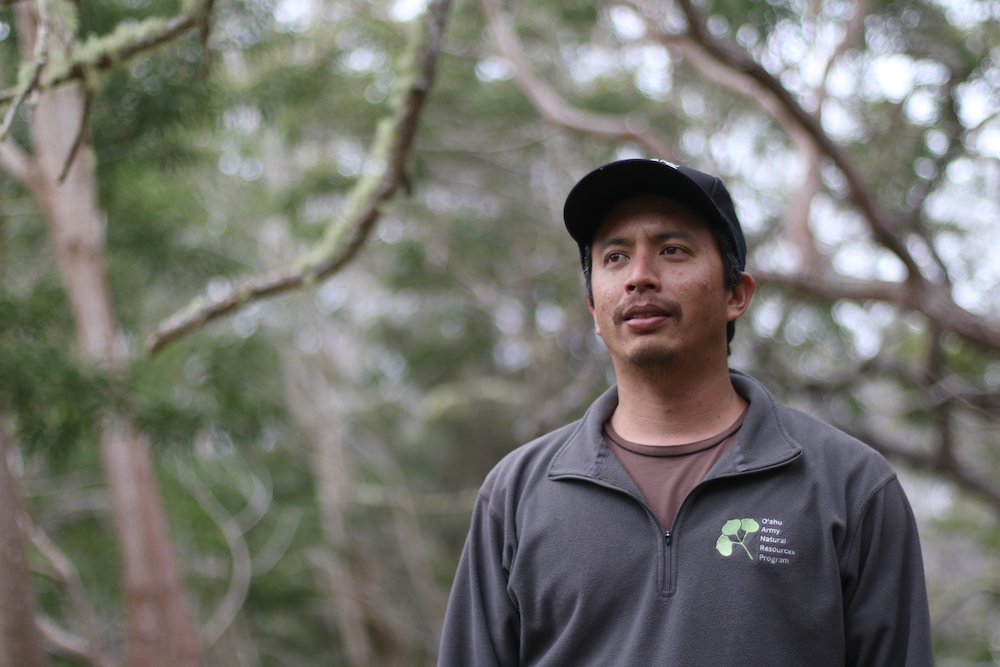 PICTURED: Reid Loo at Keauhou, Kaʻū Forest in January 2023. (Photo:Jenna Kunze).
PICTURED: Reid Loo at Keauhou, Kaʻū Forest in January 2023. (Photo:Jenna Kunze).
For Loo, a graduate of Kamehameha Schools, placing Native Hawaiʻians at the helm of conservation work only makes sense.
“Up until the ’90s and even into the 2000s, the [conservation] workforce was not representative of a lot of local demographics,” he said. “Programs like this have led to an increase in Hawaiʻians in positions of management or conservation.”
Today, half of Kamehameha Schools 17-person Natural and Cultural Ecosystems team has graduated from the school. All three natural resources management staff members, plus the team’s two interns, have also been educated within the school system.
Loo, a lifelong Hawaiʻian, has a personal stake in conservation work.
“In today's context, Hawaiʻians as a people are fighting a lot of the same things as our natural Kūpuna [ancestors]: our flora and fauna,” he said. “We’re getting priced out of our own home. We are disproportionately represented in the judicial system, and have a lot of challenges with health and access to education. If we want to remain in Hawaiʻi, we need to hold space as people and as our natural environment.”
More Stories Like This
Trump signs law that revokes some limits on drilling in Alaska’s National Petroleum ReserveSouthern Sierra Miwuk Nation Gets 900-Acres ofLand Back
Chilkat Indian Village Tells New Palmer Mine Owners They Are “Not Welcome” in Chilkat Valley
Tribes, Coastal Group Ask Army Corps to Revoke Permit for Texas Export Terminal
Michigan Tribes Tell Supreme Court: Don’t Bail Out Enbridge
Help us defend tribal sovereignty.
At Native News Online, our mission is rooted in telling the stories that strengthen sovereignty and uplift Indigenous voices — not just at year’s end, but every single day.
Because of your generosity last year, we were able to keep our reporters on the ground in tribal communities, at national gatherings and in the halls of Congress — covering the issues that matter most to Indian Country: sovereignty, culture, education, health and economic opportunity.
That support sustained us through a tough year in 2025. Now, as we look to the year ahead, we need your help right now to ensure warrior journalism remains strong — reporting that defends tribal sovereignty, amplifies Native truth, and holds power accountable.
 The stakes couldn't be higher. Your support keeps Native voices heard, Native stories told and Native sovereignty defended.
The stakes couldn't be higher. Your support keeps Native voices heard, Native stories told and Native sovereignty defended.
Stand with Warrior Journalism today.
Levi Rickert (Potawatomi), Editor & Publisher

